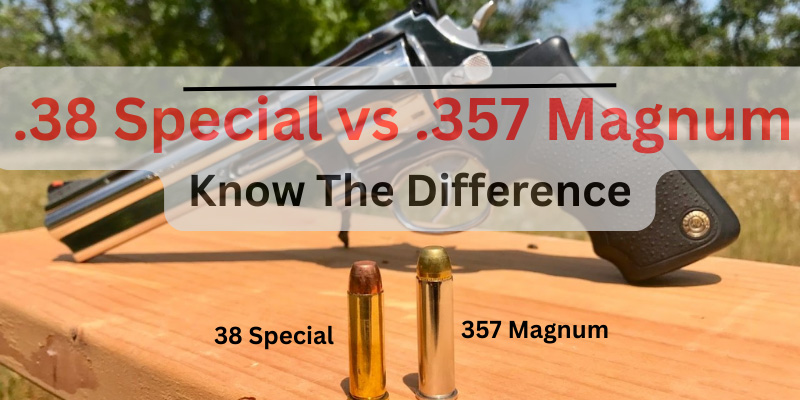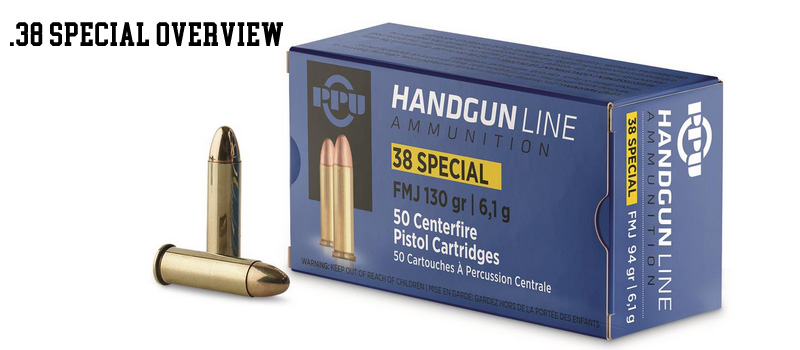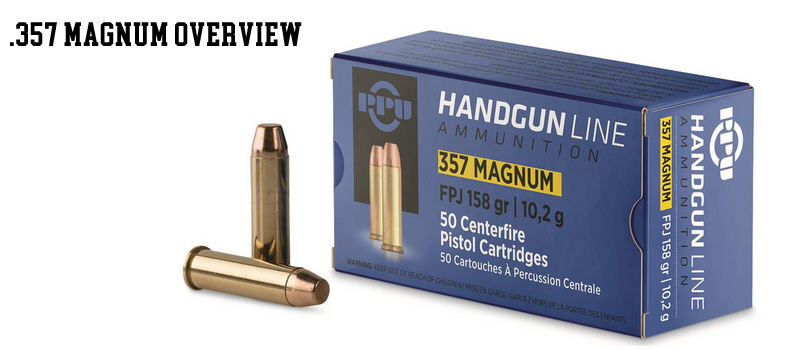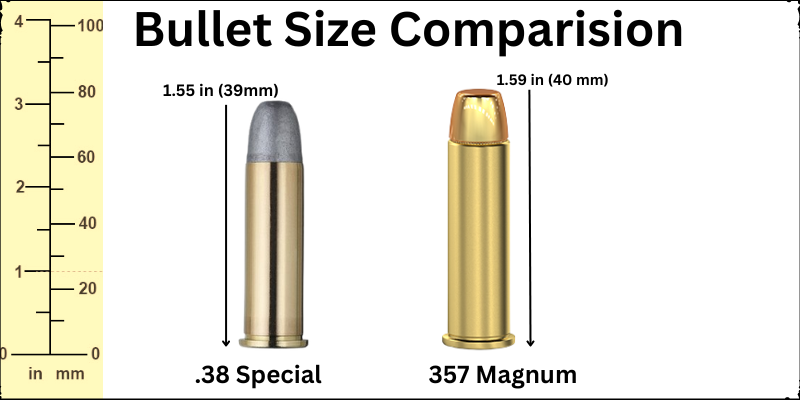.38 Special vs .357 - What Are The Differences?
A Complete Guide - What’s the Difference Between .357 Magnum and .38 Special?
If you want to buy the best-sized calibers for self-defense purposes, the .38 special & .357 are good choices. .38 Special vs. 357 are two similar but surprisingly different cartridges.
While their names imply a difference in diameter, .38 Special and .357 Magnum are the same widths. Only when looking at their length will you notice a difference?

Now, knowing the difference is essential when it comes to choosing the one caliber from these two.
This comparison guide will share information about these caliber specifications, history & development, bullet size, stopping power, recoil, velocity, applications & more.
Look deeper at 38 specials vs. 357 and what makes each great.
Specification Chart
| Specifications | .357 Magnum | .38 Special |
| Place of origin | USA | United States |
| Designer | Elmer Keith, Phillip B. Sharpe | Smith and Wesson |
| Bullet diameter | .357 in (9.1 mm) | .357 in (9.1 mm) |
| Neck diameter | .379 in (9.6 mm) | 0.379 in (9.6mm) |
| Base diameter | .379 in (9.6 mm) | 0.379 in (9.6mm) |
| Designed | 1934 | 1898 |
| Rim diameter | .440 in (11.2 mm) | 0.44 in (11mm) |
| Case type | Rimmed (R), straight | Rimmed, Straight |
| Case length | 1.29 in (33 mm) | 1.155 in (29.3mm) |
| Case length | 1.29 in (33 mm) | 1.155 in (29.3mm) |
| Overall length | 1.59 in (40 mm) | 1.55 in (39mm) |
| Maximum pressure | 35,000 psi (241 MPa) | 17,000 PSI |
| Primer type | Small pistol, magnum | Small Pistol |
.38 Special Vs .357 - Overview
The.38 Special and.357 Magnum are two well-known and long-established revolver calibers.
Despite having a similar appearance, the two are very different from one another. An overview of each cartridge will follow:
.38 Special

- The .38 Special cartridge was introduced in 1898 and has since become one of the most widely used revolver cartridges.
- It has a bullet diameter of .357 inches (hence the name "38"), the same diameter as the .357 Magnum.
- The standard .38 Special cartridge has a maximum average pressure of 17,000 pounds per square inch (psi).
- It typically comes in various bullet weights ranging from 110 grains to 158 grains, with 125 grains and 158 grains common loads.
- The .38 Special is known for its manageable recoil, making it popular for target shooting, self-defense, and law enforcement applications.
- It can be fired from revolvers chambered for .38 Special and some firearms chambered for .357 Magnum (but not vice versa).
.357 Magnum

- In 1934, the.357 Magnum cartridge was introduced as a more potent replacement for the.38 Special.
- These bullets are longer and have a slightly greater maximum average pressure, it has the same bullet diameter as the.38 Special.
- The operating pressure for the.357 Magnum cartridge is normally between 35,000 and 40,000 psi.
- It is suitable for hunting, self-defense against larger games, and use as a law enforcement round because it has significantly higher power and muzzle velocity than the.38 Special.
- Due to the.357 Magnum's greater power, it can produce noticeably more recoil than the.38 Special.
- It can be shot from revolvers that can fire.357 Magnum rounds, and the majority of.357 Magnum revolvers can also fire.38 Special rounds.
.38 Special vs .357 Magnum - History & Development
The .38 Special and .357 Magnum cartridges have a rich history of development and refinement.
.38 Special
The .38 Special cartridge was developed by Smith & Wesson in 1898 as an improvement over their earlier .38 Long Colt cartridge. The goal was to create a more effective and powerful cartridge for law enforcement and self-defense.
It became popular among law enforcement agencies and civilian shooters due to its manageable recoil and effectiveness. Over the years, the .38 Special cartridge underwent various developments, including introducing different bullet weights and loadings for specific applications.
.357 Magnum
The .357 Magnum cartridge was introduced by Smith & Wesson in 1934 as a direct result of law enforcement feedback and demand for a more powerful cartridge.
The cartridge was based on the .38 Special case but loaded too much higher pressure, increasing velocity and energy. The .357 Magnum was designed to offer superior stopping power, penetration, and range compared to the .38 Special.
.38 Special vs .357: Bullet Size & Performance

Knowing bullet size is essential to get the best shooting experience. A larger & heavier bullet will be helpful to deliver more damage to the target.
When comparing both calibers for their bullet size & performance, the .357 Magnum defeats the .38 Special. The .38 Special typically fires bullets weighing 110 to 158 grains at moderate velocities, making it suitable for self-defense and target shooting.
In contrast, the .357 Magnum can handle a wider range of bullet weights (usually 125 to 180 grains) and achieves significantly higher muzzle velocities and energies. This extra power makes the .357 Magnum ideal for hunting and self-defense against the larger games.
.38 Special vs .357: Stopping Power
When comparing the 38 Special vs. the .357 for its stopping power, The .357 Magnum is considered more powerful. The .357 Magnum can deliver devastating stopping power with appropriate bullet selection and shot placement. The increased velocity and energy of the .357 Magnum provide enhanced stopping power and penetration capabilities.
The larger power factor and deeper penetration of the .357 Magnum make it a preferred choice for self-defense scenarios where maximum stopping power is desired.
On the other hand, the 38 Special is known for its moderate power and controllable recoil. While the .38 Special can incapacitate an attacker, it may not provide the same penetration or terminal ballistics level as the .357 Magnum.
.38 Special vs .357: Ballistic Comparison
Knowing the ballistics is very essential to understanding everything that will happen to a bullet once it leaves the barrel of your firearm.
Lets see how these 2 bullets perform after leaving the barrel of your firearm.
.38 Special Ballistic
All .38 Special rounds tested clocked in under 1,000 fps muzzle velocities. In the ballistic gel, all reached the minimum penetration of 12 inches, but one round penetrated.
As for expansion, we’re looking for about .54″expansion, which none of the rounds adequately reached.
A quick look at 38 Special cartridge ballistics.
| 38 Special Bullet WEIGHT | Muzzle VELOCITY (fps) | Muzzle ENERGY (ft. lbs.) | Mid-Range TRAJECTORY (in.) | Barrel Length (in.) | |||||
|---|---|---|---|---|---|---|---|---|---|
| Muzzle | 50 yds. | 100 yds. | Muzzle | 50 yds. | 100 yds. | 50 yds. | 100 yds. | ||
| 100 Grain | 950 | 900 | n/a | 200 | 180 | n/a | 1.3 | n/a | 4-V |
| 110 Grain | 945 | 895 | 850 | 220 | 195 | 175 | 1.3 | 5.4 | 4-V |
| 110 Grain JHP | 995 | n/a | n/a | 242 | n/a | n/a | n/a | n/a | n/a |
| 125 Grain JHP | 1000 | n/a | n/a | 278 | n/a | n/a | n/a | n/a | n/a |
| 130 Grain | 775 | 745 | 710 | 175 | 160 | 120 | 1.9 | 7.9 | 4-V |
| 140 Grain Cowboy | 800 | 767 | 735 | 199 | 183 | 168 | n/a | n/a | 7.5-V |
| 140 Grain Multi-Ball | 830 | 730 | 505 | 215 | 130 | 80 | 2 | 10.6 | 4-V |
| 140 Grain JHP | 950 | n/a | n/a | 281 | n/a | n/a | n/a | n/a | n/a |
| 148 Grain | 710 | 635 | 565 | 165 | 130 | 105 | 2.4 | 10.6 | 4-V |
| 158 Grain | 755 | 725 | 690 | 200 | 185 | 170 | 2 | 8.3 | 4-V |
| 158 Grain JHP | 900 | n/a | n/a | 284 | n/a | n/a | n/a | n/a | n/a |
.357 Magnum: Ballistic
The .357 Magnum cartridge is known for its stopping power. So, as expected, it performed well in our gel test, showing high velocities and having no trouble penetrating to desired depths.
While none of the rounds tested expanded to the .54″ that we were looking for, as a whole, the .357 Magnum expanded better than the .38 Special.
A quick look at 357 Magnum cartridge ballistics.
| 337 Magnum Bullet WEIGHT | Muzzle VELOCITY (fps) | Muzzle ENERGY (ft. lbs.) | Mid-Range TRAJECTORY (in.) | Barrel Length (in.) | |||||
|---|---|---|---|---|---|---|---|---|---|
| Muzzle | 50 yds. | 100 yds. | Muzzle | 50 yds. | 100 yds. | 50 yds. | 100 yds. | ||
| 115 Grain | 1520 | n/a | n/a | 593 | n/a | n/a | n/a | n/a | n/a |
| 124 Grain | 1450 | n/a | n/a | 578 | n/a | n/a | n/a | n/a | n/a |
| 125 Grain | 1350 | 1190 | 1080 | 510 | 395 | 325 | 0.7 | 3.1 | 4" |
| 135 Grain | 1225 | 1112 | 1031 | 450 | 371 | 319 | n/a | n/a | 4" |
| 147 Grain | 1225 | 1132 | 1060 | 490 | 418 | 367 | n/a | n/a | 4" |
| 150 Grain | 1130 | 1030 | 970 | 420 | 355 | 310 | 0.9 | 4 | n/a |
.38 Special vs .357: Recoil
Recoil is one of the key factors to consider when contrasting .38 Special and.357.
The .38 Special often displays less recoil than the .357 Magnum because of its different power levels, making it more manageable, especially for novice or recoil-sensitive shooters.
It offers a comfortable shooting experience, making it a well-liked option for practice sessions and concealed carrying.
The .357 Magnum, on the other hand, produces more recoil because of its higher velocity and energy. While seasoned shooters may manage this recoil, accurate shooting with a .357 Magnum may require some practise and skill improvement.
| Cartridge | Recoil Energy (Ft-Lbs) | Recoil Velocity (Fps) |
| .357 Mag. (110; 1300; 44) | 4.1 | 9.8 |
| .357 Mag. (125; 1209; 28) | 8.9 | 18.1 |
| .357 Mag. (125; 1220; 44) | 4.6 | 10.4 |
| .357 Mag. (125; 1450; 44) | 7.2 | 13 |
| .357 Mag. (140; 1022; 44) | 4 | 9.6 |
| .357 Mag. (140; 1323; 44) | 7.9 | 13.6 |
| .357 Mag. (158; 1070; 28) | 9.4 | 18.6 |
| .357 Mag. (158; 1250; 44) | 8.7 | 14.3 |
| .357 Mag. (158; 925; 44) | 4 | 9.7 |
| .357 SIG (125; 1350; 28) | 7.4 | 16.6 |
| .38 Spec. (125; 850; 16) | 5.6 | 18.9 |
| .38 Spec. (130; 819; 36) | 2.2 | 8 |
| .38 Spec. (130; 950; 36) | 3.1 | 9.5 |
| .38 Spec. (140; 825; 36) | 2.7 | 8.8 |
| .38 Spec. (148 HBWC; 738; 36) | 2.1 | 7.8 |
| .38 Spec. +P (110; 1150; 36) | 4 | 10.7 |
| .38 Spec. +P (125; 975; 36) | 2.9 | 9.2 |
| .38 Spec. +P (158 LHP; 900; 36) | 4.3 | 11.1 |
.38 Special vs .357 : Applications
38 Special
The .38 Special is widely used for various purposes, including:
- Self-defense: The manageable recoil and adequate stopping power make it suitable for personal protection and concealed carry.
- Target shooting: The moderate recoil and availability of affordable ammunition make it popular for recreational shooting and practice.
- Law enforcement: Many law enforcement agencies historically used .38 Special revolvers, although they have largely transitioned to semi-automatic pistols in recent years.
- Revolver versatility: The .38 Special can be fired from firearms chambered for .38 Special or .357 Magnum, offering versatility to shooters with firearms in both calibers.
.357 Magnum
The .357 Magnum is known for its higher power and versatility, making it suitable for various applications, including:
- Self-defense: The .357 Magnum's greater velocity and energy offer improved stopping power and penetration, making it useful for self-defense against possible threats from both humans and animals.
- Hunting: The.357 Magnum is effective against small to medium-sized game, including deer and hogs, especially when fired from a carbine or a revolver with a longer barrel length.
- Revolver enthusiasts: The.357 Magnum is popular by handgun fans who value its strength, performance, and capacity to fire both.357 Magnum and.38 Special rounds.
- Sporting purposes: The.357 Magnum is a rifle caliber that is well suited for action shooting sports due to its higher power and flat trajectory.
.38 Special vs .357: Price & Availability
When we compare the .38 Special vs .357 by price & availability, the 38 special is less expensive & widely available. 38 Numerous manufacturers produce special ammo, and is widely available from online ammo stores.
Because of their availability and affordability, 38 special calibers are popular for individuals who frequently engage in shooting activities or require large quantities of ammunition.
On the other hand, the .357 Magnum is also widely available but a bit more expensive than the 38 special.
Conclusion
After a long debate between .38 special vs. .357, both calibers have advantages.
The .38 Special ammo, especially the +P variety, is well known for its low recoil and has a distinguished track record as a superb self-defense round.
On the other hand, if you want pure strength and power, the .357 Magnum is the handgun caliber for you. It offers high velocity and higher pressure, making it known for incredible stopping power.
However, it's important to note that all this power comes at a considerably higher recoil and monetary cost to the shooter.
Choose the caliber according to your personal preference.

